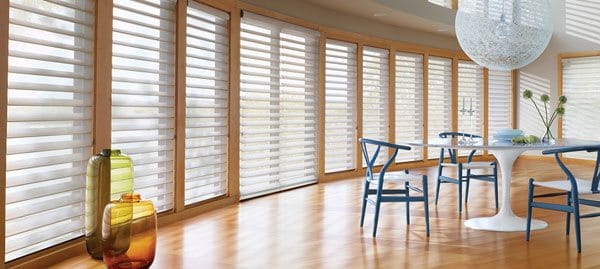
The Environmental Protection Agency (EPA) estimates that Americans spend approximately 90 percent of their time indoors. The EPA also advises that indoor air can be five times more polluted than outdoor air due to indoor air pollutants.
These pollutants range from dust mites to the off-gassing of chemicals in our furnishings into vapors called volatile organic compounds (VOCs). While these pollutants are invisible to the eye, it’s easy to see that indoor air quality is an important consideration in any home environment.
Sally Morse, Director of Creative Services at Hunter Douglas, the leading name in custom window fashions, offers some tips on decorating and maintaining a home with your family’s health and well-being in mind.
1. From the Ground Up
When it comes to flooring, a few products that can release VOCs include vinyl flooring and wall-to-wall carpeting if they contain certain adhesives, backings and sealants. Given that VOC’s tend to have higher concentrations indoors and can affect your home’s air quality, it’s best to choose flooring materials that minimize chemical off-gassing. Interior designer Robin Wilson, in her book, Kennedy Green House, a chronicle of the eco-healthy remodeling and redesign of a Kennedy family’s home, recommends hardwood with a Forest Stewardship Council certification to help ensure sustainable forestry or reclaimed wood flooring; bamboo; cork; linoleum; concrete; stone or tile.
If you can’t install new flooring, at least ensure your cleaning products are non-toxic. If they are, it should clearly state this on the label. According to Wilson, standard cleaners often have artificial scents that can overpower a room with a chemical smell. Non-toxic cleaners will frequently have an herbal scent instead of synthetic chemicals.
2. Quality at the Window
No part of the home should be overlooked when seeking to improve indoor air quality. At the window, look for products with GREENGUARD GOLD certification, such as the majority of Hunter Douglas window fashions. This means the window treatments have undergone rigorous testing and certification from UL Environment to verify they meet stringent GREENGUARD standards for low chemical emissions into indoor air during product usage.
3. The Walls Around You
Have you ever thought about what exactly is in the paint on your walls? Paints and finishes can release low-level toxic emissions into the air for years after the initial application. The source of these toxins is a variety of VOCs, which, until recently, were essential to the performance of paint.
New regulations and consumer demand have led to the development of low-VOC and zero-VOC paints and finishes.. According to the Eartheasy: Solutions for Sustainable Living website, most paint manufacturers now produce one or more non-VOC varieties of paint. Natural paints made from raw ingredients like water, plant oils and resins, plant dyes and essential oils; minerals such as clay, chalk and talcum; milk casein, natural latex, beeswax, earth and mineral dyes are also an option.
4. The Rooms that Count
Did you know you spend a third of your life sleeping? When you think of your bedroom, you want it to be a haven. However, research shows that toxins released from chemicals in the bedroom are actually one of the most significant sources of daily exposure to pollution. These chemicals can stem from linens, textiles, carpeting, furniture and conventional mattresses and are produced from components used to create each product.
When purchasing furnishings for your bedroom, it is useful to look for low-VOC, low-formaldehyde or organic options if possible. When choosing a mattress, Wilson recommends exploring eco-foam or non-toxic alternatives along with organic, pesticide-free cotton, silk, fleece or bamboo sheets. Regardless of the bedding or mattress, hypoallergenic covers for pillows and mattresses are always important. Pillows should also be washed and replaced regularly.
When it comes to your bathroom, Wilson suggests a really easy, inexpensive fix for improving indoor air quality. Your vinyl shower curtain typically has a strong chemical smell, especially when it is brand new, due to the off-gassing. She recommends swapping it out for a nylon shower curtain liner with a cotton exterior curtain.
5. Let the Air In
The EPA advises making certain there is plenty of fresh air and ventilation (e.g., opening windows and using extra fans) when painting, remodeling, or using other products that may release VOCs. The EPA also reminds us that heaters and air conditioners have filters to trap dust and other pollutants in the air and that it is important to change or clean the filters regularly, following the instructions on the package.
6. A Pocket Full of Daisies
According to the Mother Nature Network, in the late 1980’s, NASA and the Associated Landscape Contractors of America studied houseplants as a way to help purify the air in space facilities. Luckily, the plants also work in our homes and other studies corroborate these findings. Some suggestions include aloe vera, spider plants, Gerber daisies, snake plants (also known as mother-in-law’s tongue!), English ivy, azaleas and chrysanthemums.
With these tips, decorating and maintaining your home with an eye towards optimal indoor air quality should be easier.

No Comments